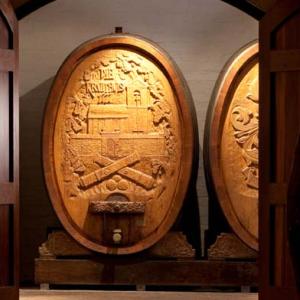For centuries, winemakers have been putting their wines into oak barrels to ferment or age over time. Originally done as a matter of convenience, it was soon apparent that the barrels themselves added another dimension of flavour to the wine, leading specialist coopers to spring up all over Europe. Oak from different countries (or even different parts of the country) offer different flavours for winemakers to choose from and the degree to which the barrels themselves are ‘toasted’ (a fire is lit inside the barrel to char the inside of the staves) provides even more levels of flavour and choice.
If you ever go and look round a winery, take a look at the stamps on the end of the barrels. You will usually find the makers mark, the region the barrel comes from and then the degree of toasting (MT, HT, LT – medium, heavy or light toast). A new barrel costs in the region of R8,000 and imparts the highest amount of oaky flavour to a wine. Gradually over the next couple of years, the barrel becomes less and less flavourful until after about 4 years, it is retired forever.
Which countries make oak barrels?
Mainly France with large forests in areas such as Nevers, Alliers and Limousin providing oak for many of France’s (and the rest of the world’s) top wines. American oak is invariably sweeter and more vanilla in character whilst Hungarian and Russian oaks are also popular. Oak grown in SA cannot be made into barrels as the trees grow too fast and the grain is too loose to be watertight.
Do you only get oak flavours from barrels?
Nope! A cheaper way is to toast barrels staves (aka planks of wood) on both sides and then throw them into tanks. This is used for popular styles of wine such as the chocolate/coffee Pinotages. You can also use wood chips or even wood essence, although thankfully this is dying out.
What exactly are the flavours you get from oak?
Oak generally has the effect of adding vanilla or buttery flavours to a wine. Sometimes it adds spice – cloves or cinnamon – sometimes hints of toast or brioche.
Does it have to be oak? Can you use another wood?
Yes you can – trials have been done with cherry, mahogony and lots of other different woods but wines just taste nicer in oak!
Does it really make that much of a difference?
Well, yes, it does actually! A recent tasting at the re-launch of the Die Bergkelder in Stellenbosch is a case in point. Legendary cellarmaster, Dr Julius Lazlo, experimented in the 80’s with different kind of oak, putting the same wine into 5 different barrels to see what the difference really was. We tasted 5 different versions of 1986 Cabernet Sauvignon, one each made in Nevers, Limousin and Alliers oak (all from France) respectively, one in Spanish oak, one in American and then finally, a blend of all the different woods. There were distinct differences between the wines with the blend actually performing best of all. For more information on the Bergkelder and all the fascinating history behind the cellar go to www.bergkelder.co.za.

